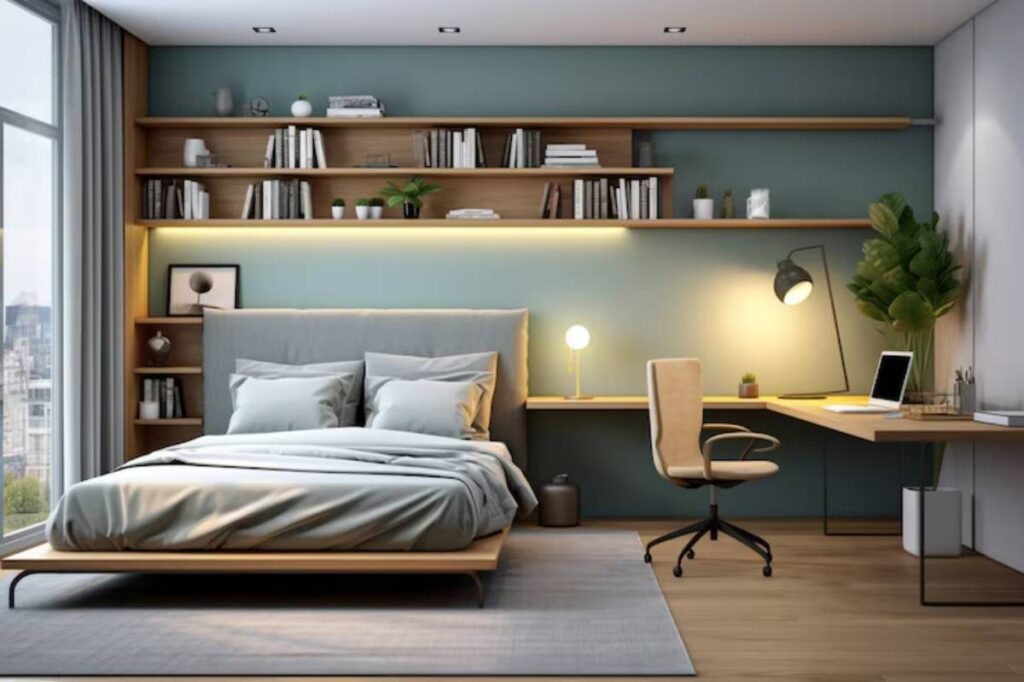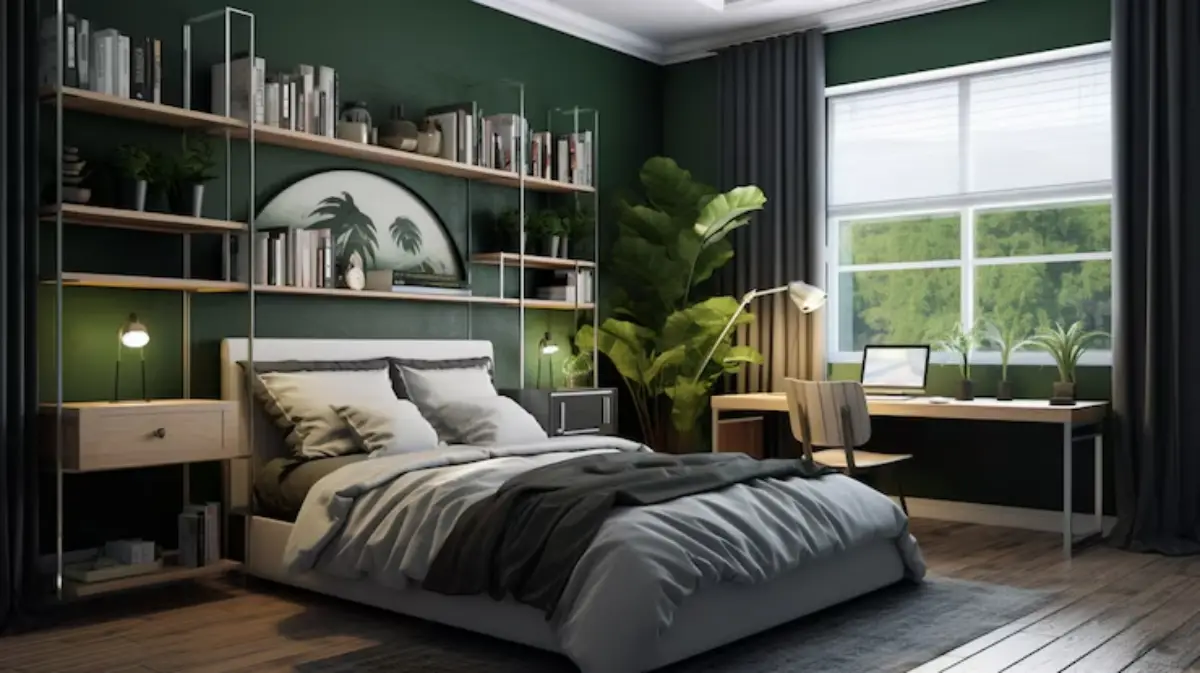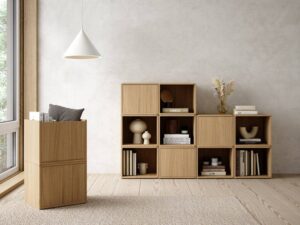The Interior Design Blog

How to Safely Use Overhead Storage in Bedrooms
When floor space runs low and wardrobes are bursting, it’s easy to feel like you’ve run out of options. But often, the solution is right above you — literally.
Overhead bedroom storage is one of the smartest ways to reclaim underused vertical space. Whether it’s a floating shelf above the bed, a row of closed cupboards near the ceiling, or a clever rail for seasonal clothes, making use of that “dead air” can completely shift how your room feels and functions.
But — and this is key — it’s got to be done safely. No one wants to worry about falling boxes above their pillow. In this guide, we’ll break down how to use ceiling and upper-wall space securely and stylishly, and how to balance ceiling shelf safety with compact, livable design.
Why Overhead Storage Works Brilliantly in Bedrooms
It Creates More Storage Without Taking Up Floor Space
In small or shared bedrooms, every metre counts.
Overhead units let you add storage:
- Without crowding the bed
- Without bulky furniture
- Without closing in your visual space
Think about the unused wall above a wardrobe or bed — or even along hallway thresholds into the room. These zones are ideal for lightweight, low-access storage.
Perfect for Items You Don’t Use Daily
Not everything needs to be arm’s reach. Overhead zones are great for:
- Spare bedding
- Off-season clothing
- Decorative storage baskets
- Books, photo albums, or travel gear
This tiered access approach frees up drawer space for items you use every day.
Adds Architectural Interest
Done right, ceiling-high shelving or mounted cabinets can visually extend your walls, drawing the eye upward and making the room feel taller — a subtle but powerful effect in compact room décor.
Mirror this layered approach with other small-space tricks, like using under-furniture space for storage, to maximise your room’s full height and depth.
Types of Overhead Bedroom Storage (And Where to Use Them)
1. Floating Shelves Above the Bed

Perfect for storing books, decor, or storage boxes. Use solid wood or engineered timber supported by concealed or metal brackets.
Where to use:
- Over a wide headboard
- Centred above a single bed
- Above desks in student or teen rooms
Bonus tip: Add a soft LED strip underneath for ambient lighting.
2. High-Mounted Cabinets
Just like kitchen overheads — but styled to match your bedroom aesthetic. Close them up to hide clutter.
Where to use:
- Above wardrobes
- On the wall opposite your bed
- Around a lofted sleeping zone
Look for shallower depths (25–30cm) so they don’t protrude too far.
3. Hanging Rails or Peg Boards
Great for airing clothes, hats, or lightweight bags.
Where to use:
- Overdressing benches or shelves
- Inside alcoves
- Near room entrances
Add them to small bedrooms as open storage that feels light and breathable — like a mini boutique setup.
4. Box Storage with Wall Anchors
Attach fabric or plastic bins to anchored brackets or rails high up the wall.
Perfect for:
- Toy storage
- Hobby or craft gear
- Tech accessories
Label them clearly and stick to lightweight content.
Overhead Safety Tips You Should Never Ignore
Anchor Into Studs or Solid Joists
This is the golden rule. Never screw shelves into plasterboard alone — even if using wall plugs. Use a stud finder to locate framing or brick behind your wall.
Use Proper Brackets & Weight Ratings
Always:
- Check the max load capacity of your brackets
- Use at least 2–3 supports for wider shelves
- Avoid cheap plastic anchors for anything over 5 kg
If you’re storing heavier items, go for wall-mounted cabinets with concealed brackets rather than open shelves.
Keep It Light — Especially Above the Bed
Reserve heavier bins or books for shelves above wardrobes or desks.
For shelves directly above the bed:
- Use baskets or bins that weigh under 5 kg total
- Store only soft or non-breakable items
- Consider closed shelves to reduce visual weight
Don’t stack books like a library above your head unless the shelving is professional grade, or it could pose a risk.
Position Shelves at a Safe Height
As a rule of thumb, aim for:
- At least 45–60cm above the headboard
- No lower than 30cm from the ceiling (to keep it usable)
- Out of direct reach from standing or sitting
This prevents bumping your head or accidentally knocking things down.
Design & Styling Tips for Visual Balance
Stick to One Colour Family
Match your shelving material to your room’s core palette —
for example:
- White or beige shelves in neutral bedrooms
- Warm-toned wood for rustic, earthy rooms
- Black or industrial metal for minimalist designs
Too many textures make a room feel cramped.
Use Baskets & Boxes for Uniformity
Open shelves can get chaotic fast. Choose 2–3 identical bins, label them discreetly, and avoid overflowing them. Soft rope, felt, or canvas bins add texture without bulk.
Add Light or Plants for Softness
Install soft LED strips under shelves to highlight the area. Or if you’ve got clearance, hang a trailing plant at one end to soften the line and break up harsh edges.
Pair this visual elevation strategy with lofted platforms for sleeping and storage for a perfectly layered look in ultra-small bedrooms.
Common Mistakes to Avoid
- Overloading shelves with too many books or heavy décor
- Using decorative brackets that aren’t weight-rated
- Mounting shelves too low, causing accidental bumps
- Ignoring symmetry or balance, leading to visual clutter
Always test the weight with your hands before committing to storing anything heavy.
Conclusion: Look Up, But Do It Right

Overhead bedroom storage can be a game changer in small homes — but only if it’s safe, functional, and thoughtfully designed. Whether you’re creating space for off-season duvets, showcasing favourite books, or simply reducing floor clutter, the key is to plan intentionally.
Use safe mounting techniques. Pick the right storage style for the right zone. And balance function with form so your room stays welcoming and breathable.
Your ceiling is more than a blank canvas. It’s storage space just waiting to be used well.









